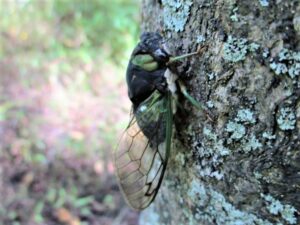
Full side view of the dog-day cicada showing the black eyes & dark green body coloration plus the clear wings with green veins. (Photo Credit: Steven K. Rettke, Rutgers Coop. Ext.)
They Get No Respect:
For at least the past 7-8 weeks, the annual “dog-day” cicadas (Neotibicen canicularis) have been heard singing throughout many NJ locations.They tend to get little respect or media attention & could be called the “weak sister” of the far more publicised periodical cicada species that were present this past spring. The annual cicadas species have less dense populations & their lifecycles are usually 2-3 years compared to the 13-17 years for the periodical cicada species. However, the dog-day cicada emergence is not synchronized, therefore some will emerge every year. Like periodical cicadas, the dog-day males also sing to females to attract a mate. However, the dog-day cicada “electric buzz-saw” screams are not synchronized & even though each individual male is loud, they are not nearly as deafening nor continuous as the noise produced by periodical cicadas. Each male sings for only about 15 seconds & when their numbers in an area are relatively sparse, there is typically many intermittent periods of silence. When populations are more dense, then there may be a continuous non-synchronized buzzing sound that emanates throughout an area.
The Glamour Girl:
During the spring of 2021 the periodical cicada (Magicicada spp.)(Brood X) got all the press & media attention when they emerged during this past spring in huge numbers within certain northeastern regions of the country. Their synchronized continuous screams were deafening throughout the day. The adult periodical cicada has distinctive red eyes & wings that are translucent with orange veins. This specific cicada species completed their life cycle a few months ago as spring ended & will now remain silent again for another 13-17 years as the slow maturing nymphs feed underground on tree roots. Then the longest lived insect will emerge again to bask in its brief glory of fame.
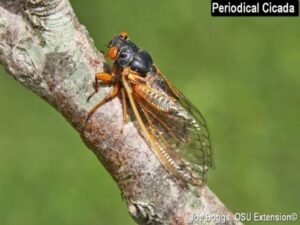
Periodical cicada species have striking coloration with distinctive red eyes, orange legs, translucent wings & orange colored wing veins. They are typically 25% smaller than the dog-day cicada. (Photo Credit: Joe Boggs, Ohio State Coop. Ext.)
Dog-Day Lifecycle:
During the early weeks of July, the annual or “dog-day” cicada (Neotibicen canicularis) emerged in most parts of NJ. The “dog-day” cicadas are so named since they are most active during the long, hot weeks of July & August. The arguably, “not so pleasant” buzzing sounds the males make will probably only last another couple more weeks as the insect completes its life cycle & the adults die. By the middle of September, many NJ neighborhoods may welcome the quiet again.
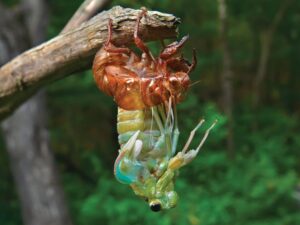
Adult dog-day cicada emerging from final nymphal molt. Most adults arrived during the weeks of July. (Photo Credit: Britannica)
Like periodical cicadas, the mated female dog-day cicadas use their ovipositors to insert eggs through the bark of small terminal twigs on trees. The resulting elongated V-shaped split to the bark causes the twigs to die-back & leaves to turn brown. The damage is more significant from the periodical cicadas because of their higher populations, but is relatively mild & hardly noticeable from the dog-days. The dead twigs typically drop to the ground or the hatched nymphs will drop themselves. They then will burrow 2-feet into the soil to feed on tree root juices (primarily xylem) until they mature years later.
After 2-3 years, the mature dog-day nymphs will emerge from the ground during the early weeks of summer & may climb-up the trunks of trees above the roots they fed upon. The adult winged cicada will vacate from the split-opened brown exoskeleton during their final nymphal molt. These empty exoskeletons can sometimes remain attached to tree trunks for an extended period long after the adults have moved on.
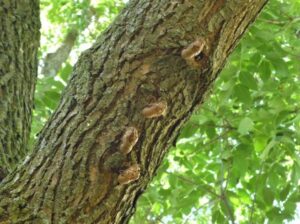
Matured dog-day nymphs leave the ground & will often climb the tree trunk above the roots they fed upon. (Photo Credit: Steven K. Rettke, Rutgers Coop. Ext.)

Close-up of dog-day cicada exoskeleton vacated by the adult. Sometimes it can remain attached to tree trunks for weeks. (Photo Credit: Steven K. Rettke, Rutgers Coop. Ext.)
The Serenading Romancer:
The male dog-day cicada sings from tall trees in the attempt to receive an invitation from a female to mate. The louder & more consistent male screams have the better chance to get the attention & interest from females. This cicada species is strictly diurnal & the singing will abruptly cease as dusk moves into darkness only to start-up again at daybreak. The typical male song lasts for about 15 seconds. The first half-dozen seconds is a gradual build-up of the buzzing call that peaks to a crescendo that lasts for another half-dozen seconds, before rapidly tapering off to silence about 3 seconds later. Peak frequency is approximately 7kHz. Unique sounds are made by individual males as they approach a receptive wing-flicking female for mating.

Dog-day cicadas are tree dwellers & can be found on many tree species. Males will often be found singing in pines trees where they are difficult to spot. (Photo Credit: Steven K. Rettke, Rutgers Coop. Ext.)
The buzzing sounds by males are produced by structures called tymbals. The pair of tymbals are located on each side of the body at the first abdominal segment. They are each positioned just behind where the hindwings are attached on the thorax. Large muscles contract causing the tymbals to bend inward. This creates a vibrating clicking sound. This sound is boosted by a large air chamber located in the abdomen of the cicada. Extremely rapid muscle contractions produce the noisy vibrations by the tymbals that resembles the buzzing of an electric saw.
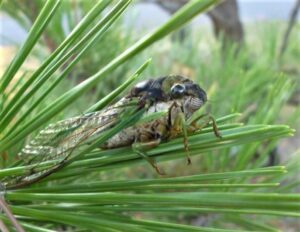
Dog-day cicadas have dark green heads & black eyes. The green wing-veins blend-in well with the pine needles. The pair of vibrating tymbals, hidden by the wings, are located just behind where each hind-wing is attached. (Photo Credit: Steven K. Rettke, Rutgers Coop. Ext.)
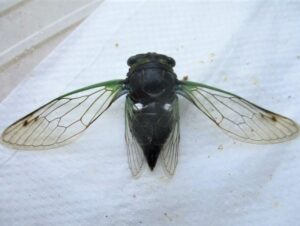
The approximate location of the pair of tymbals on this male are where the white fungal infections are shown just behind the hind-wing attachment at the 1st abdominal segment. (Photo Credit: Steven K. Rettke, Rutgers Coop. Ext.)
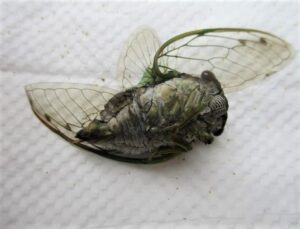
The whitish underbelly of this female dog-day cicada clearly shows the ovipositor out of the abdomen at left & the proboscis out of the head at right. (Photo Credit: Steven K. Rettke, Rutgers Coop. Ext.)
Dog-Day Cicada Archenemy:
As stated in the title of this blog, the eastern cicada killer wasp (Sphecius speciosus) is not a big fan of the singing dog-day cicada. Although the dog-day is not a major pest to trees, it can be a nuisance & the cicada killer wasp is a beneficial predator that helps keep dog-day populations in check. This wasp is one of the largest in North America & can reach sizes over 1.5 inches in length. The males can be defensive of the ground nests & will show aggressive behaviors toward trespassers. However, it is all bark & no bite since they lack a stinger. The female wasps do possess a stinger or ovipositor but are not aggressive unless severely provoked. The size of the stinger is impressive & anyone foolish enough to mess with them could be sorry since the stinger can potentially pack quite a wallop. However, reports of stings to people are extremely rare. The annual cicada species are the exclusive & only prey of the cicada killer. It does not prey on the periodical cicada species.
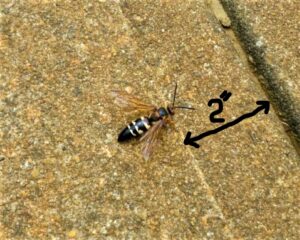
The adult cicada killer wasp can reach an impressive size of 1.6 inches in length. (Photo Credit: Steven K. Rettke, Rutgers Coop. Ext.)

Female cicada killer ovipositor (stinger) is 5 mm or 0.2 inch in length. It is exclusively used to paralyze the dog-day. (Photo Credit: Steven K. Rettke, Rutgers Coop. Ext.)
The adult cicada killers do not themselves actually feed on the dog-day cicadas that they paralyze. Instead the still alive, paralyzed dog-day is dragged into the provisioned burrowed nest by the predator where it then lays an egg on its prey. The killer wasp will seal off the underground cell & the egg will hatch two days later. The hatched larval grub can then begin to feed on the still-living dog-day. By not immediately killing the dog-day cicada, the larval grub can have fresh protein over an extended period. Furthermore, by not feeding on the vital organs first, the grub can keep the cicada alive even longer. Nature can certainly display a vicious side.
Female cicada killer wasps generally are attracted to well-drained soils located in full sun to dig their underground nesting burrows. The nests can be identified by mounds of excavated sand & loose soil. In the center of the mound will be a deep hole about the size of a nickel. Curiously, there is often a dug-out channel several inches long that can be observed leading into the hole where the cicada killer dragged a paralyzed dog-day across the mound into the burrow entrance. The photograph below re-enacts such an event.
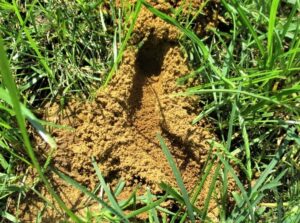
The dug-out channel shows where the cicada killer dragged a paralyzed dog-day into opening hole of burrow nest. (Photo Credit: Steven K. Rettke, Rutgers Coop. Ext.)
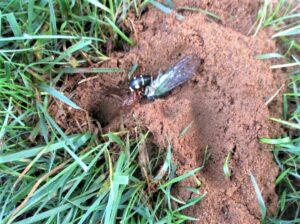
This re-enactment shows the cicada killer wasp dragging its paralyzed cicada over the soil mound & into the nesting burrow. (Photo Credit: Steven K. Rettke, Rutgers Coop. Ext.)
The cicada killer species is a solitary wasp, but as shown in the included photograph, many individual burrow nests can be seen closely together, if the environmental conditions are ideal. The same site in the photo has been used repeatedly over multiple years by new generations of predators. Unfortunately, concerned neighbors have been observed applying insecticides along the edge of this sidewalk. They mistakenly believe the wasps are a danger & need to be killed. Education over the years has helped reduce the misuse of pesticides at this particular site.

Loose & well-drained soils located in full sun provide ideal environmental conditions for many cicada killer burrow nests. (Photo Credit: Steven K. Rettke, Rutgers Coop. Ext.)
Murder Hornet Frenzy:

The Asian giant hornet is exceptionally large (up to 2-inches) & was found in the state of Washington in 2019. (Photo Credit: USDA, APHIS)
In 2019, the Asian giant hornet species (Vespa mandarinia) was discovered in the state of Washington & Canadian British Columbia. This exceptionally big hornet is the largest in the world & can potentially reach 2-inches in size. The Asian giant hornet (AGH) is a non-native honeybee killer & can be a serious threat to their hives. The accidental introduction received a lot of media attention & has created concerns from citizens in other parts of the country when they observe common wasps such as the eastern cicada killer or northern European hornets (Vespa crabro).
To help avoid mistaking the AGH or “murder hornet” from the other already established large wasps, the following photographs indicate distinguishing visual features that differentiates them. Some of the distinctive features for the AGH other than its larger size includes the exceptionally wide orange head w/dark thorax & the continuous or unbroken smooth orange & brown colored bandings or stripes that encircle the abdomen. The cicada killer wasp is commonly misidentified as a Asian giant hornet, but knowing the differences between their heads, thorax & abdomen makes ID easy. Since inadvertent introductions of non-native insects can potentially occur at any time in various parts of the country, if a large wasp appears to match the AGH photos provided, then report it to your university cooperative extension service or your state department of agriculture.
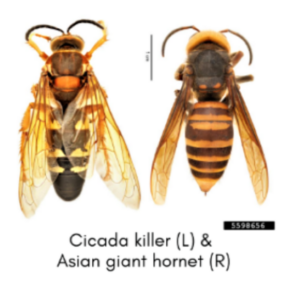
The cicada killer wasp (L) is usually slightly smaller than most Asian giant hornets (R). The heads & abdomens are distinctively different. (Photo Credit: Texas A&M AgriLife Extension Service)
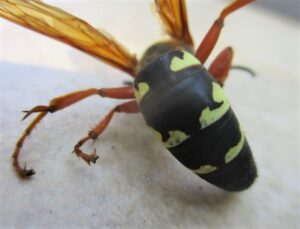
Cicada killer abdomen markings have sharp contrasting black & yellow coloration. Also the yellow peaked stripes are discontinuous & non-uniform. (Photo Credit: Steven K. Rettke, Rutgers Coop. Ext.)
Reference: Buckeye Yard & Garden onLine, by Joe Boggs, The Ohio State University, (7/16/20).
Reference: Newsweek, “Watch This Killer Wasp Drag Home an Unfortunate Cicada Snack” by Andrew Whalen, (8/24/20).

